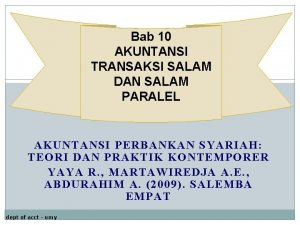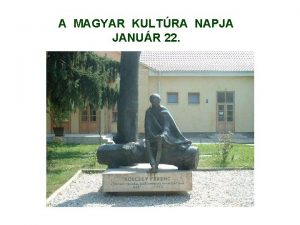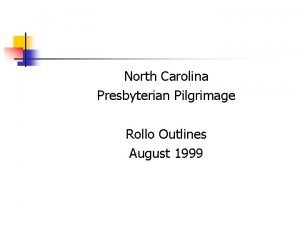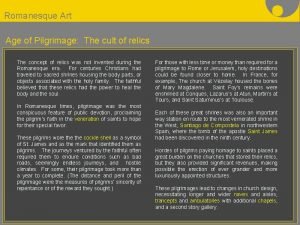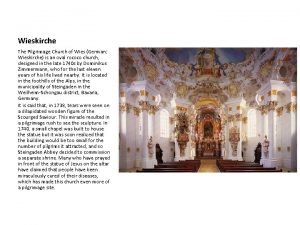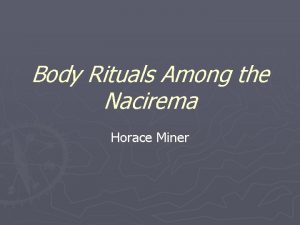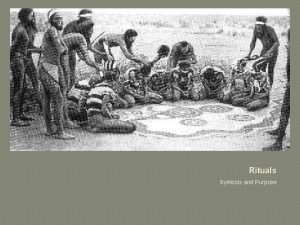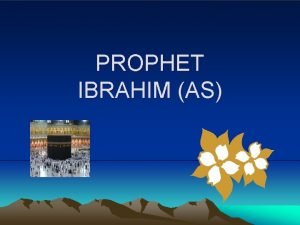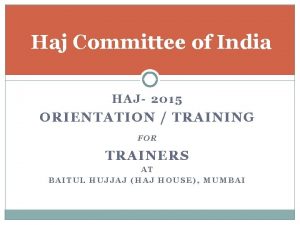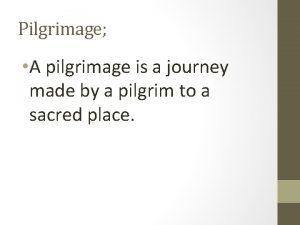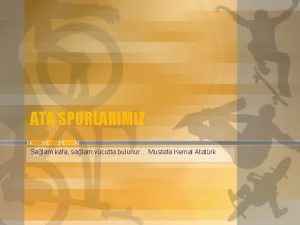Haj Muslim Pilgrimage Salam AlAttar Rituals of Islamic






































- Slides: 38

Haj (Muslim Pilgrimage) Salam Al-Attar

Rituals of Islamic Worship There are two branches of Islamic Faith: a. b. Shi’a Sunni All schools of thought consider Haj (Pilgrimage) as a pillar of Islamic worship It is enjoined on a person to perform Haj with certain conditions The person becomes involved spiritually, physically, economically, and in gaining knowledge. The memories are everlasting

What is Haj? Haj is the yearly occurring ritual of pilgrimage to Mecca by Muslims Haj is one of the Pillars of Worship in Islam Haj is enjoined on the Muslim to perform At least once in a life-time if: The person can afford it And if he is able to People hale from every country, nationality, background, financial status, and level of education In 2008, an estimate of 3 million persons performed the rites of Haj

Who should Perform Haj? Not everyone can or should perform Haj. Many times there are circumstances that make it impractical. A person has to: 1. 2. 3. 4. 5. Attain physical maturity, Have good mental capacity, Be free, Be capable financially and health-wise, and Know that travel won't endanger his life. If on the other hand you are healthy, strong enough, and can afford the trip, then you are obliged to go.

The experience of Haj is a duty whereby an individual worships Allah not only through endeavors of the body, but also through endeavors of earnings and income. Actually Haj is a form of Jihad, a spiritual Jihad of unique value. No one can ever define the unique value of Haj unless he or she has taken part in it. Each individual comes from the Haj with a matchless spiritual uplift all his or her own, with a unique experience that only he or she can appreciate and treasure for the rest of his or her life. This is true whether the person happens to be highly educated or not, of a technical inclination or not, from a developed country or not. The experience of Haj is so absorbing for an individual and so gratifying, that it easily enriches every person and affects his or her future actions and thoughts.

The experience of Haj Because of the tremendous difference in the standard of living of different countries, and the educational standard of the people participating, a person will be taken aback when he sees such a sea of humanity. Habits, race, and language aside, most people seem to go in groups, and each seems to have its own group behavior and manners. There is little sleep if any for most people, and the whole territory; the towns, streets, and the community vibrate with life and activity be it day or night, and whatever the hour may be. Any man or woman, therefore, can have a fairly accurate idea of how other people live, their level of economics, thinking, behavior, Such an observer will have gained tremendously in understanding the people of the world, and will find himself or herself swept with intense emotion. The person finds himself or herself as one individual among millions, just one member of Allah's great creation.

The experience of Haj When you are at the Ka'ba performing Salat and praying with millions of people, you will be awed by the overwhelming experience. The mere massiveness of the panorama of worshippers is breathtaking, and you will experience a deep feeling of awe and veneration. Yet, there is a quietude of a special nature despite all this; there is serenity and calmness, there is gentleness and tranquility mixed with a feeling of veneration. Each person feels that he is in the house of Allah, and each is taken by that awe inspiring feeling. There is even more.

Comparative illustration between blood circulation in the human body and migration pattern to and from Mecca at the time of Pilgrimage. Blue arrows on the globe represent the migration to the Ka’ba (black cube) by prospective pilgrims. The call out box outlines the rites of pilgrimage that take place in Mecca. Red arrows on the globe represent the migration of pilgrims back to their countries of origin.

About the Previous Diagram The diagram of Haj rites portrays the major rites of pilgrimage, whose listed details may not be encompassing of all schools of thought. Depending on the school of thought being followed, there are some minor differences in rulings, order of steps, as well as selection of supplications and conducted Prophetic recommendations. Like the deoxygenated blood returning to the heart, Muslim pilgrims embark on a journey to the central house of worship, which God (Allah) Almighty chose to be in the land of Mecca, Arabia; the cubical edifice known as “the Ka’ba. ”

During the season of pilgrimage Haj takes place in the twelfth lunar month of Dhul Hijjah, Similar to the revitalization of an organ upon the nourishment of oxygen-full blood returning to it, the pilgrims’ return home is happily welcomed by all, Muslims undergo their spiritual “oxygenation” by completing the pilgrimage process. In the last step of that process (which begins at the Ka’ba), Muslims return for their final visit to this very House of God (Baitullaah). At that point, God-willing, Muslims are ready to be “pumped” back to their countries of origin where they can resume their roles in society.

The many steps of Haj in brief 10 Tawaf 1 Tawaf 2 Sa’iy 9 Sacrificing 3 Arafat Haj 8 Casting Visitation of the Prophet’s Mosque before or after the rites 4 Muzdalifa 7 Mina 6 Sa’iy 5 Tawaf

Rites of Haj Briefly said, the rites of Hajj include: Circling the Ka'ba seven times (Tawaf), and going seven times between the elevations of Safa and Marwa (Sa'iy). Then the pilgrims stand together on the wide plain of Arafat and join in collective prayer for God's forgiveness, Spending overnight in Muzdalifah Doing Tawaf and Sa'iy again Staying in Mina for 3 days (stoning the symbol of the devil) Doing Tawaf and Sa'iy again

Parameters of Haj Influence 2. Political factor 3. Functional factor 1. Social factor Haj 5. Timing factor 4. Economic factor Above factors reflect influences on the interested person

Influence of Haj The journey to Mecca and performance of pilgrimage is a unifying experience for Muslims, physically and spiritually. During Hajj, one witnesses the coming together of over 2 -3 million Muslims from all walks of life, the educated and the illiterate, the dark-skinned and the lighter-toned, the wealthy and the poor, and the list goes one. Furthermore, people of all walks of life, join together for a collective spiritual cleansing and revitalization. With this unification, comes yet another form of unity; that of various facets of Islamic history which revolve around this Ancient House (Baitul-Ateeq; another Arabic name for the Ka’ba).

Who usually goes for Haj? For Pilgrimage Muslims come from just about every corner in the world. Wherever there are Muslims, there will be someone who is anxious to perform the Haj. They come from Africa, Asia, America, Europe, Australia And other far away places.

How often to perform Haj? Usually you perform Haj once in your lifetime, even though you are encouraged to do it more often. If you want to go more often, it will be your privilege to do so. Actually, much depends on how easy it is for you to go for Haj (Pilgrimage), and how eager and willing you are Haj is done in the month of Dhul‑Hijjah, a lunar month, thus it moves forward 11 days a year

What do we learn from Haj? In performing Haj you practice and learn better about the brotherhood of man. You gain a high sense of equality, a high sense of purity. You glorify the Almighty at the sacred place. Your heart will awaken to a deep spiritual call in you. You see history in action. The biggest international meeting ever gathers for this Duty of Haj. Thousands of people of different languages, races and nationalities will be praying the same way, performing pilgrimage the same way, all dedicated for the same call. You see the millions of Muslims united in spirit of dedication and in their call for the Almighty. It makes you very close to other Muslims. It has a good educational value.

Historicity of Haj Seeing the Ka’ba at first reminds one of Prophets Abraham and Ishmael as they worked to revive the foundations of the first house of God. As the Muslims make their ritual Tawaf (circulating around the Ka’ba) they come across the Black Stone, stationed in the East corner of the Ka’ba. The Black Stone brings to mind a unification of all Muslims along the chain of history, stretching from Abraham to the present time.

Garb of Ihram Simple garb, for every participant in Haj, all dressing alike and all with equal rights: be they rich or poor, be they black, white or yellow, or be they high ranking persons or ordinary ones Everyone sees himself like others surrounding him People get a feeling of brotherhood People try their best to be in their best behavior

When you are in Ihram is a state of peace, self‑denial, total submission to God Almighty. When you are in a state of Ihram, you reach the pinnacle of being good: there will be no evil talk whatsoever, there will be no quarrels or disputes, you don't hurt or kill an animal, even an insect, brotherhood and goodness are to prevail, pleasures of the flesh are strictly forbidden. In Ihram you are completely dedicated to Allah Almighty. So your manners and behavior should show it.

In response to the command of God “Here I am, Oh God, at Thy command! Here I am at Thy command! You are without associate! Here I am at Thy command! To You are all Praise, Grace and Dominion! You are without associate O God!”…

The Ka’ba: The house of Almighty God

As Muslims see themselves Surrounded by a mass of people clothed in a simple white cloth and unanimously engaged in prayer, Muslim pilgrims remind themselves of their mission in life and their relationship with God, as they circle the Ka’ba and repeat these words. Looking around oneself and at the magnificent structure of the Ka’ba, the person is seized with a sense of awe Often with a seizure of deep emotion, a person cannot help but cry, seeing himself so insignificant in this overwhelming house of God

The excitement of the pilgrimage experience and revival of historical events continues as pilgrims move on to pace between the mounts of Al-Safa and Al-Marwa. Going back and forth for seven times commemorates the hardship of Hajar, wife of Abraham, as she ran back and forth between those two mounts seeking water for her thirsty baby. All the while, baby Ishmael (driven by a divine instinct), continued his kicking into the sand, and to his mother’s delight when she witnessed water gushing from the ground at Zamzam. Located about 15 meters east of the Ka’ba, this blessed Zamzam water well continues to quench the thirst of pilgrims to this very day.

At Mount Arafat As the crowd of pilgrims hurry to complete their last pillar of Islam, they gather at what is perhaps the most historical location for all of humanity, mount Arafat. “Arafat” from the Arabic word meaning “to get to know. ” Pilgrims join one another towards the end of the pilgrimage journey in seeking forgiveness from Allah collectively, in acknowledgement of their previous committed sins and seeking of refuge to Allah (swt) for protection from evil instincts and forces in days to come.

Picture of Mount Arafat

In Mina for 3 days After standing on Arafat, the final visit to the Ka’ba is perhaps the most spiritually inspiring and revitalizing experience. Glory be to You and You alone O Allah… How millions of people come to this holy house of Yours in Your remembrance, While countless others direct their prayers to this same location; O Allah. Truly, You are the All-Wise, the All. Mighty and All-Knowing of all that passed and that which is yet to take place.

The stages of performing the Haj

Steps of Performing Haj: Sunni way 1 2 3 4 5 6 IHRAM: Cleans self (Ghusl), wear simple garment (Ihram) & make intention for Omrah. 7 8 9 TAWAF al-IFADAH: (10 th Dhul-Hijjah or after) Perform Tawaf Al. Ifadhah around Ka’ba, Sa'iy between Safa TAWAF al-IFADAH: (10 th Dhul-Hijjah or after) Perform Tawaf Al-Ifadhah & Marwa (After Tawaf, ALL restrictions lifted) 10 GOING HOME: Now Haj rites are complete, although not a rite of Haj it is recommended to visit the Prophet’s Mosque in Medina before heading home. OMRAH: Perform Omrah rites: Tawaf (circumambulate around Ka’ba), pray 2 Rak'as behind Ibrahim shrine, Sa’y (walk between Safa & Marwa). Trim hair & remove garments. MINA: (8 th Dhul-Hijjah noon à 9 th Dhul-Hijjah Fajr): Go to Mina, place Ihram again, make intention for Haj & MINA: (8 th Dhul-Hijjah noon à stay in Mina. ARAFAT: (9 th Dhul-Hijjah noon [Yawm-e-Arafat] à 9 th Dhul-Hijjah sunset): Go to mount Arafat, pray Dhuhr ARAFAT: (9 th Dhul-Hijjah noon [Yawm-e-Arafat] à & Asr, stay on mountain till sunset, make recommended prayers & supplications, MUZDALIFAH: (9 th Dhul-Hijjah after sunset): Go to Muzdalifah at sunset, pray Maghrib & Ishaa there, stay overnight & pray Fajr the next day. MINA: (10 th Dhul-Hijjah sunrise; Eid day) Head to Mina at sunrise, go to Jamrat Al-Aqaba & stone it (7 pebbles), slaughter sacrifice, shave head/trim hair. Take off Ihram (all Ihram restrictions are now lifted except sexual intercourse) MINA: (11, 12 & 13 th Dhul-Hijjah): Return to Mina (stay 3 days), stone 3 Jamrat each day (small, medium & Al -Aqaba), pilgrim may leave on the 12 th after stoning if he/she wishes FAREWELL TAWAF: (After 13 th Dhul-Hijjah): Return to Mecca, perform Tawaf around Ka’ba and perform 2 Rak'a prayer of Tawaf should be last thing done in Mecca).

Steps of Performing Haj: Shi’a way 1 2 3 4 5 6 IHRAM: Cleans self (Ghusl), wear simple garment (Ihram) 7 8 9 10 TAWAF al-ZIYARAH: (10 th Dhul-Hijjah) Perform Tawaf al-Ziyarah around Ka’ba, pray 2 Rak'as, Sa'iy between Safa & Marwa. Then perform Tawaf-un-Nisaa’ & its prayer (After Tawaf, all restrictions lifted). OMRAH: Perform Omrah al. Tamatu’ rites: Tawaf, pray 2 Rak'as behind Ibrahim shrine, Sa'iy (walk between Safa OMRAH: Perform Omrah al-Tamatu & Marwa), Taqseer (trim hair). MINA: (8 th Dhul-Hijjah [Day of Tarwiyah] afternoon à à 9 th Dhul-Hijjah Fajr) Place Ihram in Mecca after Dhuhr MINA: (8 th Dhul-Hijjah [Day of Tarwiyah & Asr prayers. Make intention for Haj. Go to & stay in Mina. ARAFAT: (9 th Dhul-Hijjah noon [Yawm-e-Arafat] à 9 th Dhul-Hijjah sunset): Go to mount Arafat after sunrise, ARAFAT: (9 th Dhul-Hijjah noon [Yawm-e-Arafat] à pray Dhuhr & Asr, stay on mountain till sunset, make recommended prayers & supplications. MUZDALIFAH: (9 th Dhul-Hijjah after sunset) Go to Muzdalifah at sunset, pray Maghrib & Ishaa there, stay overnight & pray Fajr the next day. MINA: (10 th Dhul-Hijjah sunrise; Eid day) Head to Mina at sunrise, go to Jamrat Al-Aqaba & stone it (7 pebbles), slaughter sacrifice, shave head/trim hair. All Ihram restrictions are lifted except intimacy to wife, perfume & hunting. MINA: (11, 12, & 13 th Dhul-Hijjah) Return to Mina (stay 3 days), stone 3 Jamrat each day (small, medium & Al. Aqaba), pilgrim may leave on the 12 th after stoning if he/she wishes FAREWELL TAWAF: (13 th Dhul-Hijjah) Return to Mecca, perform Tawaf-ul- Widaa around Ka’ba and perform its prayer. (Tawaf should be last thing done in Mecca). : GOING HOME Now Haj rites are complete, although not a rite of Haj it is recommended to visit the Prophet’s Mosque in Medina before heading home.

Tawaf (Circling the Ka’ba) Circling the Ka’ba, seven times A massive corpus of humanity All moving in unison All pleading forgiveness All aspiring for purification of the self All and every one is occupied with his own self

Al-Haram Al-Shareef, the Grand Mosque A picture of one of the gateways to the Grand Mosque. The Ka’ba occupies the very center of the Mosque There are numerous gateways to this massive Structure The feat of 2 -3 million Muslims performing the rites within two weeks is mind boggling A person is seized with awe and delightful apprehension upon seeing the Mosque

The Prophet’s Mosque A view of the Prophet’s Mosque The Prophet is buried inside, A fantastic pull takes on a person upon approaching the site As if an invisible fountain of blessing and reverence overwhelms the approaching person Deep abiding love overtakes the visitor who prays inside

The Prophet’s Mosque at night The huge mosque is equal in surface area to the town of Medina at the time of the Prophet It can hold about ¾ million people praying at the same time It is supported by numerous columns inside It has retractable ceilings for cooling or heating effects It is surrounded by very spacious courtyards

The Site of Abraham be the Ka’ba Prophet Abraham, along with his son Ishmael built the Ka’ba They dedicated it for the worship of God They both prayed for the welfare of man Just by the Ka’ba is the site of Prophet Abraham Muslims pray two Rak’as by the site, out of reverence

In conclusion Discussed were highlights of the Haj in Discussed were h brief: General view of Haj Personal account of the Haj and its social influence Haj influence on the believer Technical steps of the rite Pictures about certain aspects

Finally Let us Read Surah al-Asr Together

Be in Allah’s Care Thank you and May God Bless you. Dr. A. S. Hashim
 Akad salam paralel
Akad salam paralel Allahumma anta salam wa minka salam
Allahumma anta salam wa minka salam Allahumma antassalam waminkassalam
Allahumma antassalam waminkassalam Salam paralel adalah
Salam paralel adalah Haj amin al-husseini quotes
Haj amin al-husseini quotes Meeqat boundary map
Meeqat boundary map Mp haj committee
Mp haj committee Haj de bűneink miatt gyúlt harag kebledben
Haj de bűneink miatt gyúlt harag kebledben North carolina presbyterian pilgrimage
North carolina presbyterian pilgrimage Hailey comet cult
Hailey comet cult Pilgrimage church of wies
Pilgrimage church of wies Pilgrimage to cythera
Pilgrimage to cythera Flights to glendalough
Flights to glendalough Pilgrimage of grace banner
Pilgrimage of grace banner On pilgrimage
On pilgrimage Sankassa pilgrimage
Sankassa pilgrimage The holy mouth man
The holy mouth man Lutheranism beliefs
Lutheranism beliefs Turkish gold coins wedding gift
Turkish gold coins wedding gift Lakota keeping of the soul ceremony
Lakota keeping of the soul ceremony Hmong shaman rituals
Hmong shaman rituals Micro cosmos psychology
Micro cosmos psychology Folk songs religious works court music and shaman rituals
Folk songs religious works court music and shaman rituals Example of anthropomorphism
Example of anthropomorphism Religious rituals examples
Religious rituals examples Rituals symbols
Rituals symbols Taoist practices and rituals
Taoist practices and rituals Consumer rituals
Consumer rituals Supernatural rituals
Supernatural rituals A prescriptive ritual that one that is:
A prescriptive ritual that one that is: Compadrazgo definition
Compadrazgo definition Wabarakaatuh
Wabarakaatuh Salam contract
Salam contract Ibrahim allah salam
Ibrahim allah salam Usmar salam
Usmar salam Teori relativitas dalam perbuatan melawan hukum
Teori relativitas dalam perbuatan melawan hukum Heeadsss formu
Heeadsss formu Selamat siang dan salam
Selamat siang dan salam As salam alaykoum wa rahmatoullahi wa barakatouh
As salam alaykoum wa rahmatoullahi wa barakatouh



